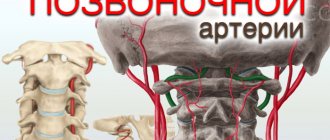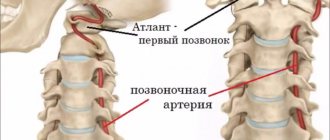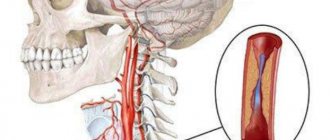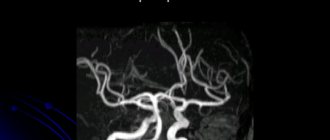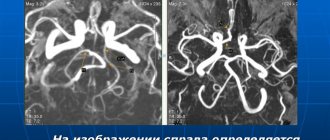In what cases is ultrasound of the neck vessels prescribed?
Experts agreed that preventive testing of the functioning of blood vessels is necessary in the following cases:
- After 45 years, both men and women;
- If you have a history of diabetes;
- With regular use of oral contraceptives;
- Persons who have had a stroke or heart attack;
- With elevated blood cholesterol levels;
- Heavy smokers and anyone who regularly drinks alcohol;
- For acute and chronic diseases of the heart and blood vessels;
- For epilepsy;
- With high or low blood pressure, as well as its fluctuations;
- With strong weather sensitivity;
- If there is a suspicion of migraine;
- For osteochondrosis of the cervical spine.
An ultrasound examination may also be prescribed to a patient before surgery on blood vessels or the heart. In addition to specific diagnoses, research can be carried out due to the following complaints:
- There is a creaking or constant whistling in the ears;
- Frequent headaches bother you;
- There is regular dizziness;
- There are problems with memory and concentration;
- “Floaters” often flash before your eyes.
If we are talking about a newborn, diagnostics of the neck vessels can be carried out if the baby’s head is irregularly shaped or if there are suspicions of the presence of serious pathological processes. This often happens if the child was not born naturally, but through surgery, or if the birth was complicated.
This examination has absolutely no contraindications, since ultrasound has no harmful effects. If the doctor has sent you for an examination, do not refuse under any circumstances and be sure to go for an ultrasound. With the help of ultrasound, you can prevent dangerous complications by detecting ailments in the initial stages of development.
What is the essence of the disease
It is impossible to understand pathology without knowing the norm. The brain receives blood from two large vascular systems: the internal carotid and vertebral arteries. Each of these vessels is paired and brings blood to a specific area of the right or left hemisphere of the brain. The junction of the terminal branches of these two arteries is called the Circle of Velisius. This is a very important anatomical formation that provides compensation for blood flow if one of the main vessels is blocked for some reason. Thus, the brain has the ability to self-regulate its blood flow, protecting itself from oxygen starvation and damage.
The right vertebral artery, as one of the powerful components of the circle of Velisius, departing from the subclavian artery, enters the spinal canal of the transverse processes of the cervical vertebrae and is directed along it into the cranial cavity. At the same time, it makes several strong bends, passing through narrow, inert holes. The area of its branching and blood supply is represented by the structures of the posterior cranial fossa of the corresponding side (cerebellum, medulla oblongata, occipital lobe of the hemispheres).
When talking about hypoplasia of the right vertebral artery, we mean its congenital underdevelopment and narrowing of the diameter. Naturally, under such conditions, the corresponding areas of the brain will be deprived of normal blood supply. If such a pathology is combined with an open circle of Velisium, there is an extremely high risk of severe ischemic (stroke) brain damage.
Do I need to prepare for an ultrasound of the neck vessels?
No special preparation is required, but in 1-2 days it is advisable to minimize the impact of factors that may affect the state of the cardiovascular system. Try not to drink a lot of tonic drinks - strong tea, coffee, energy drinks, give up alcohol. It is better not to smoke before the test. If you take any medications regularly, talk to your doctor about taking them on the day of the test - some medications can affect blood flow, and your doctor may advise stopping them for the day or delaying taking them.
Causes of vertebral artery syndrome
The most common cause of vertebral artery circulatory disorders is atherosclerotic plaque. Less common are stratification (dissection) of the artery, compression of it in the neck or at the entrance to the skull, and inflammatory diseases (vasculitis). It is quite difficult to accurately determine the likelihood of developing a stroke with such a localized lesion. According to anatomical studies, damage to the vertebral arteries during death from ischemic stroke was observed in 12% of cases.
Damage to the intracerebral parts of the vertebrobasilar system more often leads to ischemic strokes than narrowing of the artery in the neck. The risk of developing ischemic events with such lesions is about 7% per year. Symptoms of vertebral artery syndrome are being diagnosed more and more often. Many factors influence the development of the syndrome. It usually represents a combination of cerebrovascular arteriosclerosis and cervical spondylosis (degenerative changes in intervertebral disc tissue) as the main clinicopathological components.
How to study the vessels of the neck
When visiting an ultrasound diagnostician’s office, the doctor usually asks you to remove jewelry from your neck and ears and put your long hair in a ponytail so that nothing interferes with the examination process. Next, the patient lies on a flat couch, with his head towards the doctor. The gel is applied to the skin of the neck and the sensor is moved over it. The head is thrown back or tilted. First, the carotid artery is examined, then all other vessels located in the neck.
The procedure lasts no more than 45 minutes. The doctor may also conduct the examination in a sitting or standing position and ask you to tilt your head. At the end of the procedure, the doctor gives the results of the study to the patient.
Forecast
With atherosclerosis of the vertebral artery, it is quite difficult to give a prognosis for the life and health of the patient. With large narrowings, blood flow is compensated by the second vertebral artery; in addition, there is collateral blood flow. There have not yet been large studies assessing the risk of stroke with damage to the vertebral arteries. However, the fact remains that strokes in the vertebrobasilar system account for at least 25% of all strokes and are much more severe than strokes associated with the carotid artery. Therefore, the identification of significant narrowing of the vertebral artery should be a reason to eliminate this risky condition.
Without identifying and eliminating the causes of the development of vertebral artery syndrome, the prognosis for recovery is unfavorable. Most often, the patient's condition gradually worsens, which negatively affects the quality of life.
The most difficult thing is to identify the exact cause. Knowing the cause will allow it to be eliminated surgically or endovascularly and relieve the patient from painful symptoms.
Advantages and disadvantages of the procedure
Today, almost every medical institution has the necessary equipment to conduct ultrasound of the neck vessels. Let's consider the advantages of this technique:
- This method is absolutely safe;
- The procedure can be performed at any age;
- She has no direct contraindications;
- The process is absolutely painless and does not cause discomfort.
- The only disadvantage we can note is the lack of information content - this is not the main method of diagnosing diseases, but only an auxiliary one.
Symptoms of the disease
Hypoplasia of the left vertebral artery is not as common as the right one. Therefore, when discussing the clinical manifestations of their damage, attention is primarily focused on damage to the right vertebral artery. Manifestations of decompensated disturbance of blood flow through this vessel are reflected in the table.
| General cerebral symptoms |
|
| Focal symptoms of vascular disorders in the cerebral hemispheres |
|
| Focal symptoms of damage to the occipital lobe of the brain |
|
| Stem and autonomic reactions | Instability of blood pressure with its strong changes. |
| Cerebellar disorders |
|
Typically, manifestations of hypoplasia of the right vertebral artery develop gradually. These do not have to be all the symptoms listed in the table. The patient can note only some of them, which depends on which part of the brain at a particular moment feels the greatest circulatory deficiency. Symptoms are transient, periodically exacerbating and then subside. This intermittent course masks the true problem under the guise of any other diseases (neurocirculatory dystonia, dyscirculatory encephalopathy, etc.). In case of prolonged uncorrected progression of brain damage symptoms, there is a high risk of developing pre-stroke conditions or even stroke. Therefore, it is extremely important to detect the true problem in time.
Symptoms of hypoplasia of the right vertebral artery are not specific and can be observed in any disease that leads to disruption of normal blood supply and brain function. The diagnosis can only be established using special diagnostic methods.
Treatment
You can help in two ways:
- Conservative therapy. This treatment of vertebral artery hypoplasia involves the administration of drugs that improve blood properties, blood supply to the brain and metabolic processes in it. This does not cure the problem, but only protects the brain from critical ischemic changes. For these purposes, trental, actovegin, vinpocetine, ceraxon, cinnarizine, cerebrolysin, thiocetam, blood-thinning drugs are used;
- Surgery. It is associated with great difficulties and is used only if it is impossible to compensate for cerebral blood flow in other ways. Modern neurovascular surgeons perform endovascular surgery. Its essence lies in the introduction of a special dilator (stent) into the lumen of the narrowed vertebral artery. It increases the diameter of the pathological section of the artery, restoring normal blood flow. This intervention is performed similarly to the diagnostic procedure - angiography and can be carried out during its implementation.
Treatment of hypoplasia of the right vertebral artery does not always bring the desired results. It all depends on the length of the narrowed area and the presence of connections between different arterial vessels of the brain (circle of Velisius). If it is sufficiently developed, it can compensate for almost any circulatory disturbance.
Diagnostics
It is carried out under the supervision of a neurologist; if necessary, a specialized surgeon is involved.
The examination is quite simple, gives high-quality results immediately, not counting difficult situations.
Among the events:
- Oral interview with the patient. To record complaints, make a list of symptoms and put forward hypotheses.
- Anamnesis collection. Doctors are especially interested in the course of pregnancy in the mother, if such data is available. To a lesser extent, lifestyle, habits, hereditary factor.
- Dopplerography of the vessels of the neck and brain. Also duplex scanning. Studies aimed at visualizing tissues, assessing the speed of blood flow and its quality. Determination of violations, their severity, localization. Can be carried out with functional tests. Turning the head, etc. This gives a more complete picture.
- Angiography. Of necessity. For visualization of blood vessels.
- The same effect is achieved through MRI, only the level of detail is many times higher. Appointed in controversial cases.
- General blood test and biochemistry with an expanded picture of the lipid spectrum. As part of the diagnosis of atherosclerosis. Allows you to detect excess cholesterol and other fatty compounds. Which can become the culprit of the disease.
It's enough. If necessary, consultations with other specialists are indicated, but these are speculative individual cases. Other scenarios are unlikely.
Prevention
Simple preventive measures will help prevent negative consequences for the body. If you regularly play sports, before training you should drink some water and perform a light back massage. This simple tactic helps to speed up the blood, improve metabolism and absorb the necessary amount of moisture into the intervertebral discs.
Try not to lift or hold heavy objects with outstretched arms. You need to learn how to carry weights correctly so as not to injure your back. With an even posture, you need to squat down, take the load and straighten your legs with it. At the same time, place your hands as close to your body as possible. Distribute the load evenly, so you don't have to carry it in one hand if you can carry two bags in both hands. Use bags, carts and rolling suitcases to transport heavy items.
When doing heavy physical work, which is inherently associated with lifting weights, wear a special support belt or corset. Do not lift loads weighing more than 10 kg. Use comfortable shoes in everyday life, giving preference to models made from natural raw materials that securely and securely support your foot.
Women, especially during pregnancy, should avoid wearing high-heeled shoes, as they are very harmful to the spine. After being in a bent position for a long time, you can hang on the bar or stretch up.
Vessels
Anterior Cerebral Artery: Segments, Resistance Index, Normal, Aneurysm, Branches
Feb 03, 2021 Kokh V. A.
13615
Vessels
Duplex Scanning of Brachiocephalic Arteries: What is BCA, Explanation
Feb 03, 2021 Kokh V. A.
10245
Vessels
Main causes and symptoms
The causes of the disease are related to the intrauterine development of the child:
- bruise and injuries to the expectant mother,
- excessive use of alcohol, drugs,
- nicotine addiction;
- irradiation with certain types of gamma rays, with prolonged overheating;
- infectious diseases: influenza, rubella, toxoplasmosis.
Hypoplasia of the left or right vertebral artery leads to the gradual onset of symptoms, making it very difficult to diagnose.
Among the main signs of the disease are:
- frequent dizziness;
- causeless pain in the head;
- decreased sensitivity of individual parts of the body;
- deterioration of movement coordination;
- decreased vision and hearing;
- deterioration of attention, memory and concentration.
All of these symptoms occur with varying frequency. They are characteristic of pathology of the left or right vertebral artery of prolonged development. At the same time, patients often experience sudden changes in mood, depression, severe weakness and fatigue. Weather dependence may also appear when a person begins to feel unwell due to temperature changes and changes in atmospheric pressure. In addition, sleep disturbance may occur.
With the development of this disease, a significant narrowing of the vascular lumen occurs in the area where it enters the bone canal leading into the cranial cavity. As a result, insufficient blood begins to flow into the brain. This factor explains hemodynamic abnormalities in VA underdevelopment.
Any symptoms that arise in the presence of pathology are caused by the fact that the vertebral arteries supply the brain with nutrients and nourishment, and even minor disturbances in their work are manifestations of deterioration in cerebral blood flow. Over the years, the symptoms intensify, and this is not surprising: the vessels begin to lose elasticity and become “clogged.” Therefore, the lumen narrows even more.
The small diameter of the PA can be on the right side or on the left. Hypoplasia of the right vertebral artery is observed in almost 10% of citizens. Diseases of the left VA are much less common.

